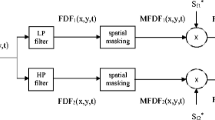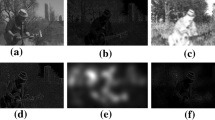Abstract
It is important for practical application to design an effective and efficient metric for video quality. The most reliable way is by subjective evaluation. Thus, to design an objective metric by simulating human visual system (HVS) is quite reasonable and available. In this paper, the video quality assessment metric based on visual perception is proposed. Three-dimensional wavelet is utilized to decompose video and then extract features to mimic the multichannel structure of HVS. Spatio-temporal contrast sensitivity function (S-T CSF) is employed to weight coefficient obtained by three-dimensional wavelet to simulate nonlinearity feature of the human eyes. Perceptual threshold is exploited to obtain visual sensitive coefficients after S-T CSF filtered. Visual sensitive coefficients are normalized representation and then visual sensitive errors are calculated between reference and distorted video. Finally, temporal perceptual mechanism is applied to count values of video quality for reducing computational cost. Experimental results prove the proposed method outperforms the most existing methods and is comparable to LHS and PVQM.













Similar content being viewed by others
Explore related subjects
Discover the latest articles, news and stories from top researchers in related subjects.References
Wang Z, Sheikh RH, Bovik CA. Objective video quality assessment. In: Furht B, Marques O, editors. The handbook of video databases: design and applications. Florida: CRC Press; 2003. p. 1041–78.
ITU-R BT.500-11. Methodology for the subjective assessment of the quality of television pictures. 2002.
Wang Z, Bovik CA. Modern image quality assessment. New York: Morgan and Claypool Publishing Company; 2006.
Yuan Y, Evans A, Monro D. Low complexity separable matching pursuits. IEEE Int Conf Acoust Speech Signal Process. 2004;3(17–21):725–8.
Yuan Y, Monro D. Improved matching pursuits image coding. IEEE Int Conf Acoust Speech Signal Process. 2005;2:201–4.
Monro D, Yuan Y. Bases for low complexity matching pursuits image coding. IEEE Int Conf Image Process. 2005;2(11–14):249–52.
Yuan Y, Monro D. 3D wavelet video coding with replicated matching pursuits. IEEE Int Conf Image Process. 2005;1(11–14):69–72.
Li X, Tao D, Gao X, Lu W. A natural image quality evaluation metric. Signal Process. 2009;89(4):548–55.
ATIS Technical Report T1.TR.PP.74, Objective video quality measurement using a peak-signal-to-noise-ratio (PSNR) full reference technique. 2001.
Sarnoff Corporation, J. Lubin. Sarnoff JND Vision Model. Contribution to IEEE G-2.1.6 compression and processing subcommittee. 1997.
Winkler S. A perceptual distortion metric for digital color video. In Proc SPIE, 3644: 175–184, San Jose, CA, Jan. 23–29, 1999.
Watson AB, Hu J, McGowan JF. DVQ: a digital video quality metric based on human vision. J Electron Imag. 2001;10(1):20–9.
Hekstra AP, Beerends JG, Ledermann D, de Caluwe FE, Kohler S, Koenen RH, Rihs S, Ehrsam M, Schlauss D. PVQM—a perceptual video quality measure. Signal Process Image Commun. 2002;17(10):781–98.
VQEG. Final report from the video quality experts group on the validation of objective models of video quality assessment, phase I VQEG. 2000. 2000Available: http://www.vqeg.org/.
Wang Z, Lu L, Bovik AC. Video quality assessment based on structural distortion measurement. Signal Process Image Commun. 2004;19(2):121–32.
Mei T, Hua X-S, Zhu C-Z, Zhou H-Q, Li S. Home video visual quality assessment with spatio-temporal factors. IEEE Trans Circuits Syst Video Technol. 2007;17(6):699–706.
Lu Z, Lin W, Yang Xiaokang, Ong EP, Yao S. Modeling visual attention’s modulatory aftereffects on visual sensitivity and quality evaluation. IEEE Trans Image Process. 2009;14(11):1928–42.
Wang Z, Li Q. Video quality assessment using a statistical model of human visual speed perception. J Opt Soc Am A. 2007;24(12):B61–9.
Wandell BA. Foundations of vision. Sinauer Associates. 1995.
Moyano E, Quiles FJ, Garrido A, Orozco-Barbosa L, Duato J. Efficient 3-D wavelet transform decomposition for video compression. International Workshop on Digital and Computational Video, 118–125, Feb. 2001.
Wang C, Ma K-L. A statistical approach to volume data quality assessment. IEEE Trans Vis Comput Graphics. 2008;14(3):590–602.
Mallat SG. A theory for multiresolution decomposition: the wavelet representation. IEEE Trans Pattern Anal Mach Intell. 1989;11(7):674–93.
Kelly DH. Motion and vision II. Stabilized spatio-temporal surface. J Opt Soc Am. 1979;69(10):1340–9.
Jia Y, Lin W, Kassim AA. Estimating just-noticeable distortion for video. IEEE Trans Circuits Syst Video Technol. 2006;16(7):820–9.
Narita N. Subjective-evaluation method for quality of coded images. IEEE Trans Broadcasting. 1994;40(1):7–13.
Tan KT, Ghanbari M, Pearson DE. An objective measurement tool for MPEG video quality. Signal Process. 1998;70(3):279–94.
Ninassi A, Meur OL, Callet PL, Barba D. Considering temporal variations of spatial visual distortions in video quality assessment. IEEE J Sel Topics Signal Process. 2009;3(2):253–65.
Winkler S. A perceputal distortion metric for digital color video IV. Proc SPIE Human Vis Electron Imag. 1999;3644:175–84.
Van den Branden Lambrecht CJ. A working spatio-temporal model of the human visual system for image restoration and quality assessment applications. Proc IEEE Int Conf Acoust Speech Signal Process. 1996;4:2291–4.
Masry M, Hemami SS, Yegnaswamy S. A scalable waveletbased video distortion metric and applications. IEEE Trans Circuits Syst Video Technol. 2006;16(2):260–73.
Chou C-H, Chen C-W. A perceptually optimized 3-D subband codec for video communication over wireless channels. IEEE Trans Circuits Syst Video Technol. 1996;6(2):143–56.
Ong E, Lin W, Lu Z, Yao S, Etoh M. Visual distortion assessment with emphasis on spatially transitional regions. IEEE Trans Circuits Syst Video Technol. 2004;14(4):559–66.
Gunawan IP, Ghanbari M. Reduced-reference video quality assessment using discriminative local harmonic strength with motion consideration. IEEE Trans Circuits Syst Video Technol. 2008;18(1):71–83.
Pan Q, Zhang L, Dai G, Zhang H. Two de-noising methods by wavelet transform. IEEE Trans Signal Process. 1999;47(12):3401–6.
Zhang L, Paul B, Wu X. Multiscale LMMSE-based image denoising with optimal wavelet selection. IEEE Trans Circuits Syst Video Technol. 2005;15(4):469–81.
Gao X, Lu W, Tao D, Li X. Image quality assessment based on multiscale geometric analysis. IEEE Trans Image Process. 2009;18(7):1409–23.
Lu W, Zeng K, Tao D, Yuan Y, Gao X. No-reference image quality assessment in contourlet domain. Neurocomputing. 2010;73(1):784–94.
Li X, Lin S, Yan S, Xu D. Discriminant locally linear embedding with high-order tensor data. IEEE Trans Syst Man Cybern Part B. 2008;38(2):342–52.
Tao D, Li X, Wu X, Maybank SJ. General tensor discriminant analysis and Gabor features for gait recognition. IEEE Trans Pattern Anal Mach Intell. 2007;29(10):1700–15.
Acknowledgements
We want to thank the helpful comments and suggestions from the anonymous reviewers. This research was supported by the National Natural Science Foundation of China (60771068, 60702061, 60832005), the Ph.D. Programs Foundation of Ministry of Education of China (No. 20090203110002), the Natural Science Basic Research Plane in Shaanxi Province of China (2009JM8004), the Open Project Program of the National Laboratory of Pattern Recognition (NLPR) in China and the National Laboratory of Automatic Target Recognition, Shenzhen University, China.
Author information
Authors and Affiliations
Corresponding author
Rights and permissions
About this article
Cite this article
Lu, W., Li, X., Gao, X. et al. A Video Quality Assessment Metric Based on Human Visual System. Cogn Comput 2, 120–131 (2010). https://doi.org/10.1007/s12559-010-9040-9
Published:
Issue Date:
DOI: https://doi.org/10.1007/s12559-010-9040-9




